Management Accounting and Financial Planning: A Strategic Review
VerifiedAdded on 2023/06/17
|13
|3826
|295
Essay
AI Summary
This essay provides a detailed analysis of management accounting and financial planning, focusing on the application of relevant costs in pricing decisions, both in the short and long term. It critically evaluates the usefulness and limitations of various capital investment techniques like Net Present Value, Payback Period, Internal Rate of Return, and Accounting Rate of Return in making investment choices. The essay also discusses the strategic role of budgeting in supporting businesses beyond the Covid-19 pandemic and examines different methods taxing authorities might use to assess the reasonableness of transfer prices, providing a comprehensive overview of key concepts in management accounting.
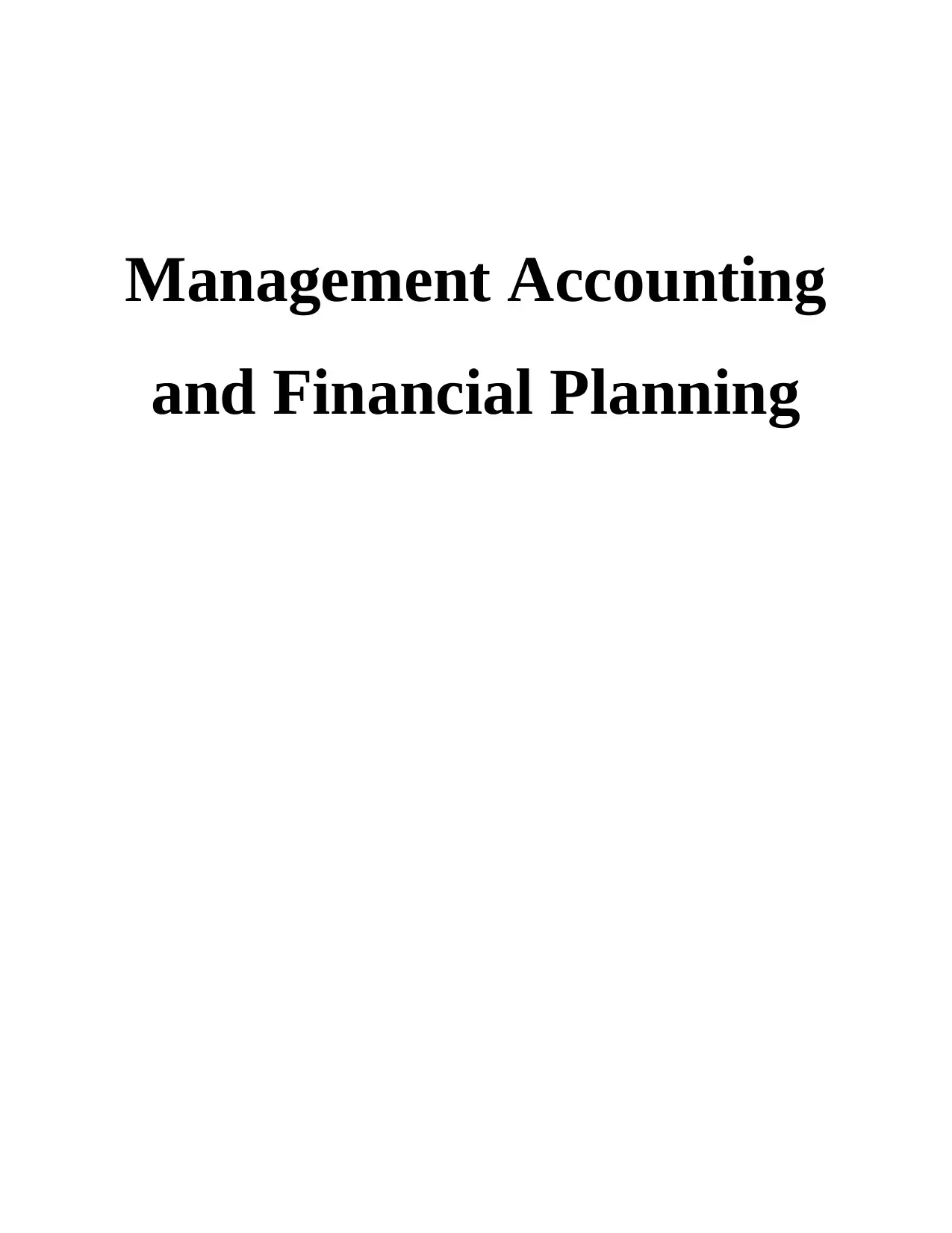
Management Accounting
and Financial Planning
and Financial Planning
Paraphrase This Document
Need a fresh take? Get an instant paraphrase of this document with our AI Paraphraser

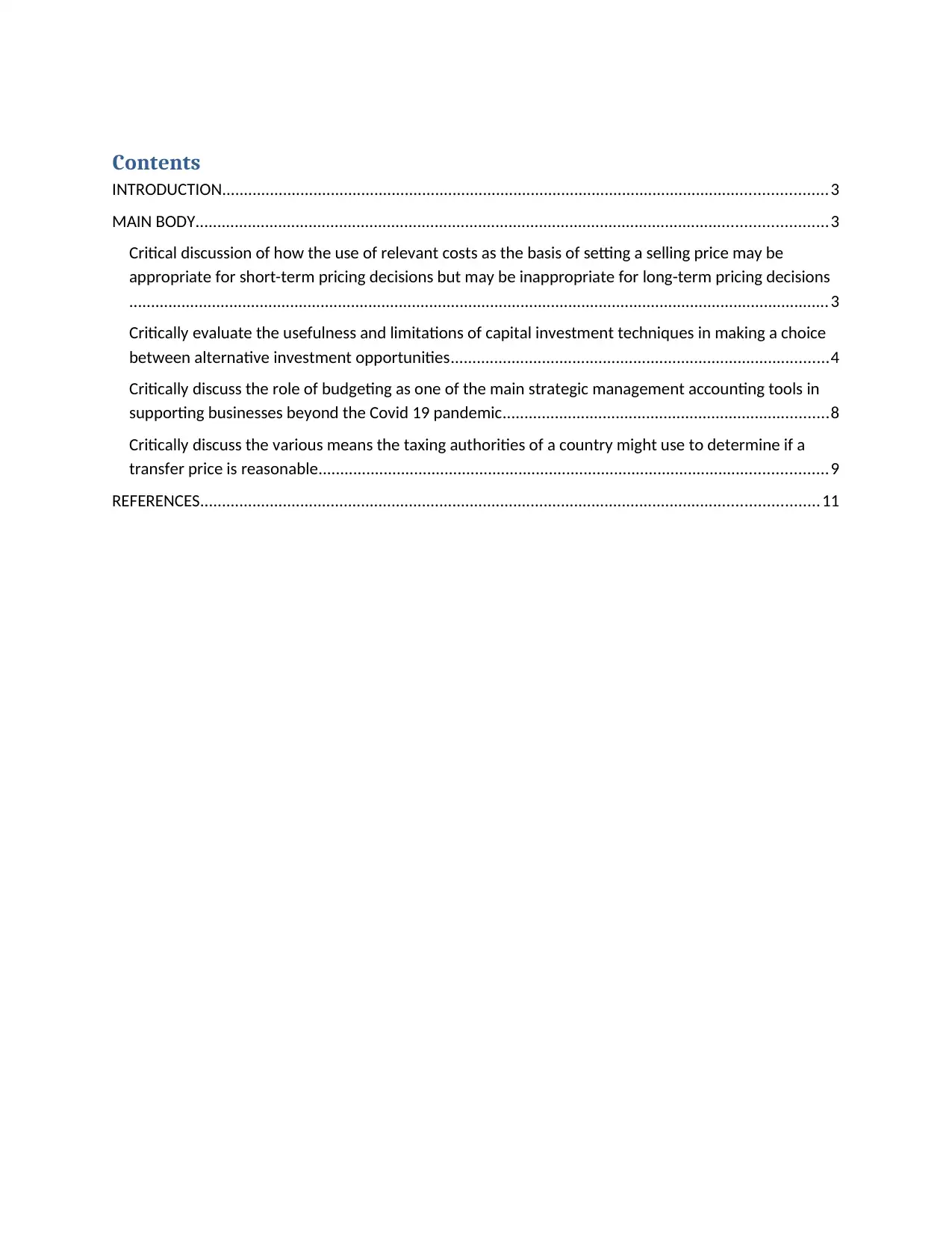
Contents
INTRODUCTION...........................................................................................................................................3
MAIN BODY.................................................................................................................................................3
Critical discussion of how the use of relevant costs as the basis of setting a selling price may be
appropriate for short-term pricing decisions but may be inappropriate for long-term pricing decisions
.................................................................................................................................................................3
Critically evaluate the usefulness and limitations of capital investment techniques in making a choice
between alternative investment opportunities.......................................................................................4
Critically discuss the role of budgeting as one of the main strategic management accounting tools in
supporting businesses beyond the Covid 19 pandemic...........................................................................8
Critically discuss the various means the taxing authorities of a country might use to determine if a
transfer price is reasonable.....................................................................................................................9
REFERENCES..............................................................................................................................................11
INTRODUCTION...........................................................................................................................................3
MAIN BODY.................................................................................................................................................3
Critical discussion of how the use of relevant costs as the basis of setting a selling price may be
appropriate for short-term pricing decisions but may be inappropriate for long-term pricing decisions
.................................................................................................................................................................3
Critically evaluate the usefulness and limitations of capital investment techniques in making a choice
between alternative investment opportunities.......................................................................................4
Critically discuss the role of budgeting as one of the main strategic management accounting tools in
supporting businesses beyond the Covid 19 pandemic...........................................................................8
Critically discuss the various means the taxing authorities of a country might use to determine if a
transfer price is reasonable.....................................................................................................................9
REFERENCES..............................................................................................................................................11
⊘ This is a preview!⊘
Do you want full access?
Subscribe today to unlock all pages.

Trusted by 1+ million students worldwide
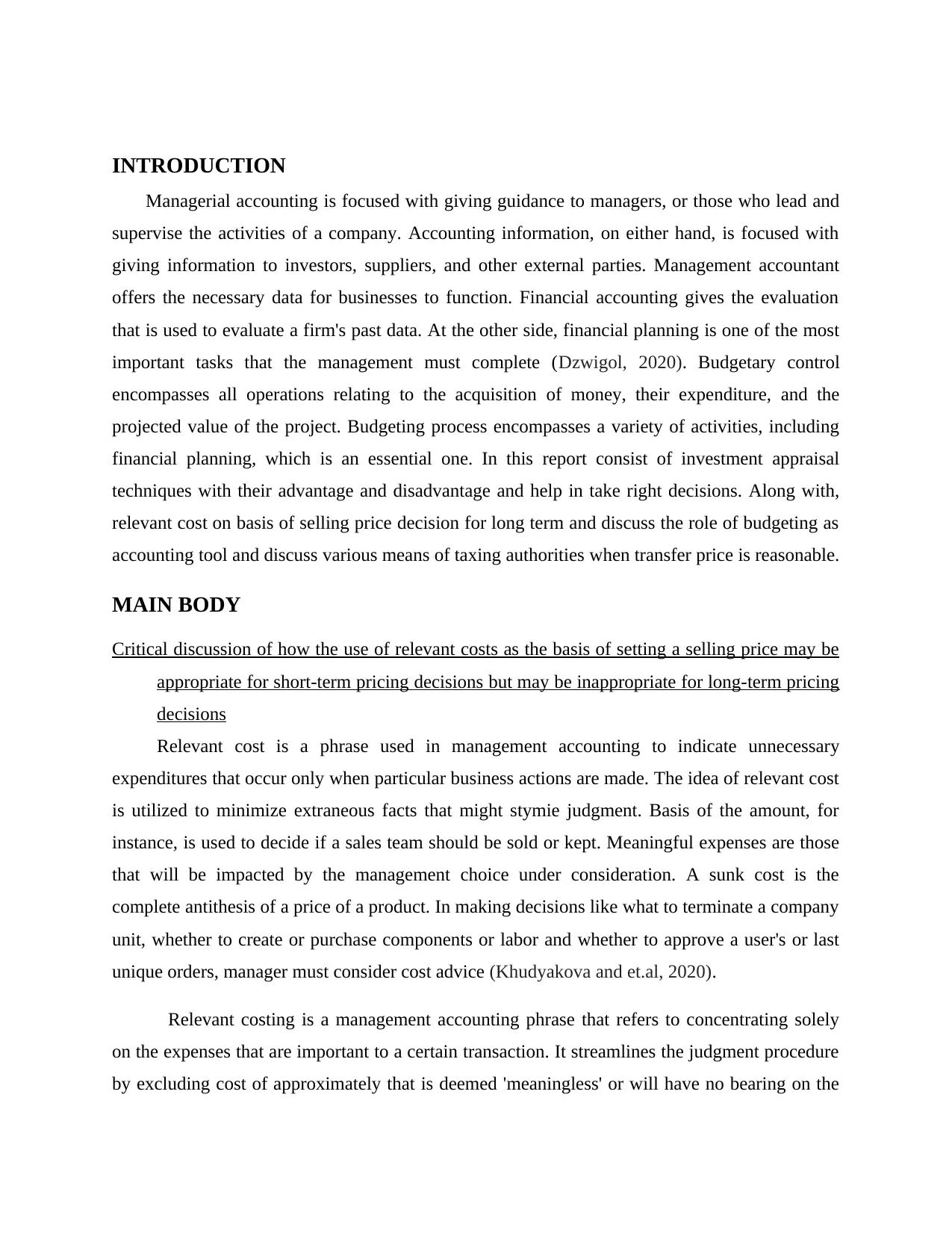
INTRODUCTION
Managerial accounting is focused with giving guidance to managers, or those who lead and
supervise the activities of a company. Accounting information, on either hand, is focused with
giving information to investors, suppliers, and other external parties. Management accountant
offers the necessary data for businesses to function. Financial accounting gives the evaluation
that is used to evaluate a firm's past data. At the other side, financial planning is one of the most
important tasks that the management must complete (Dzwigol, 2020). Budgetary control
encompasses all operations relating to the acquisition of money, their expenditure, and the
projected value of the project. Budgeting process encompasses a variety of activities, including
financial planning, which is an essential one. In this report consist of investment appraisal
techniques with their advantage and disadvantage and help in take right decisions. Along with,
relevant cost on basis of selling price decision for long term and discuss the role of budgeting as
accounting tool and discuss various means of taxing authorities when transfer price is reasonable.
MAIN BODY
Critical discussion of how the use of relevant costs as the basis of setting a selling price may be
appropriate for short-term pricing decisions but may be inappropriate for long-term pricing
decisions
Relevant cost is a phrase used in management accounting to indicate unnecessary
expenditures that occur only when particular business actions are made. The idea of relevant cost
is utilized to minimize extraneous facts that might stymie judgment. Basis of the amount, for
instance, is used to decide if a sales team should be sold or kept. Meaningful expenses are those
that will be impacted by the management choice under consideration. A sunk cost is the
complete antithesis of a price of a product. In making decisions like what to terminate a company
unit, whether to create or purchase components or labor and whether to approve a user's or last
unique orders, manager must consider cost advice (Khudyakova and et.al, 2020).
Relevant costing is a management accounting phrase that refers to concentrating solely
on the expenses that are important to a certain transaction. It streamlines the judgment procedure
by excluding cost of approximately that is deemed 'meaningless' or will have no bearing on the
Managerial accounting is focused with giving guidance to managers, or those who lead and
supervise the activities of a company. Accounting information, on either hand, is focused with
giving information to investors, suppliers, and other external parties. Management accountant
offers the necessary data for businesses to function. Financial accounting gives the evaluation
that is used to evaluate a firm's past data. At the other side, financial planning is one of the most
important tasks that the management must complete (Dzwigol, 2020). Budgetary control
encompasses all operations relating to the acquisition of money, their expenditure, and the
projected value of the project. Budgeting process encompasses a variety of activities, including
financial planning, which is an essential one. In this report consist of investment appraisal
techniques with their advantage and disadvantage and help in take right decisions. Along with,
relevant cost on basis of selling price decision for long term and discuss the role of budgeting as
accounting tool and discuss various means of taxing authorities when transfer price is reasonable.
MAIN BODY
Critical discussion of how the use of relevant costs as the basis of setting a selling price may be
appropriate for short-term pricing decisions but may be inappropriate for long-term pricing
decisions
Relevant cost is a phrase used in management accounting to indicate unnecessary
expenditures that occur only when particular business actions are made. The idea of relevant cost
is utilized to minimize extraneous facts that might stymie judgment. Basis of the amount, for
instance, is used to decide if a sales team should be sold or kept. Meaningful expenses are those
that will be impacted by the management choice under consideration. A sunk cost is the
complete antithesis of a price of a product. In making decisions like what to terminate a company
unit, whether to create or purchase components or labor and whether to approve a user's or last
unique orders, manager must consider cost advice (Khudyakova and et.al, 2020).
Relevant costing is a management accounting phrase that refers to concentrating solely
on the expenses that are important to a certain transaction. It streamlines the judgment procedure
by excluding cost of approximately that is deemed 'meaningless' or will have no bearing on the
Paraphrase This Document
Need a fresh take? Get an instant paraphrase of this document with our AI Paraphraser
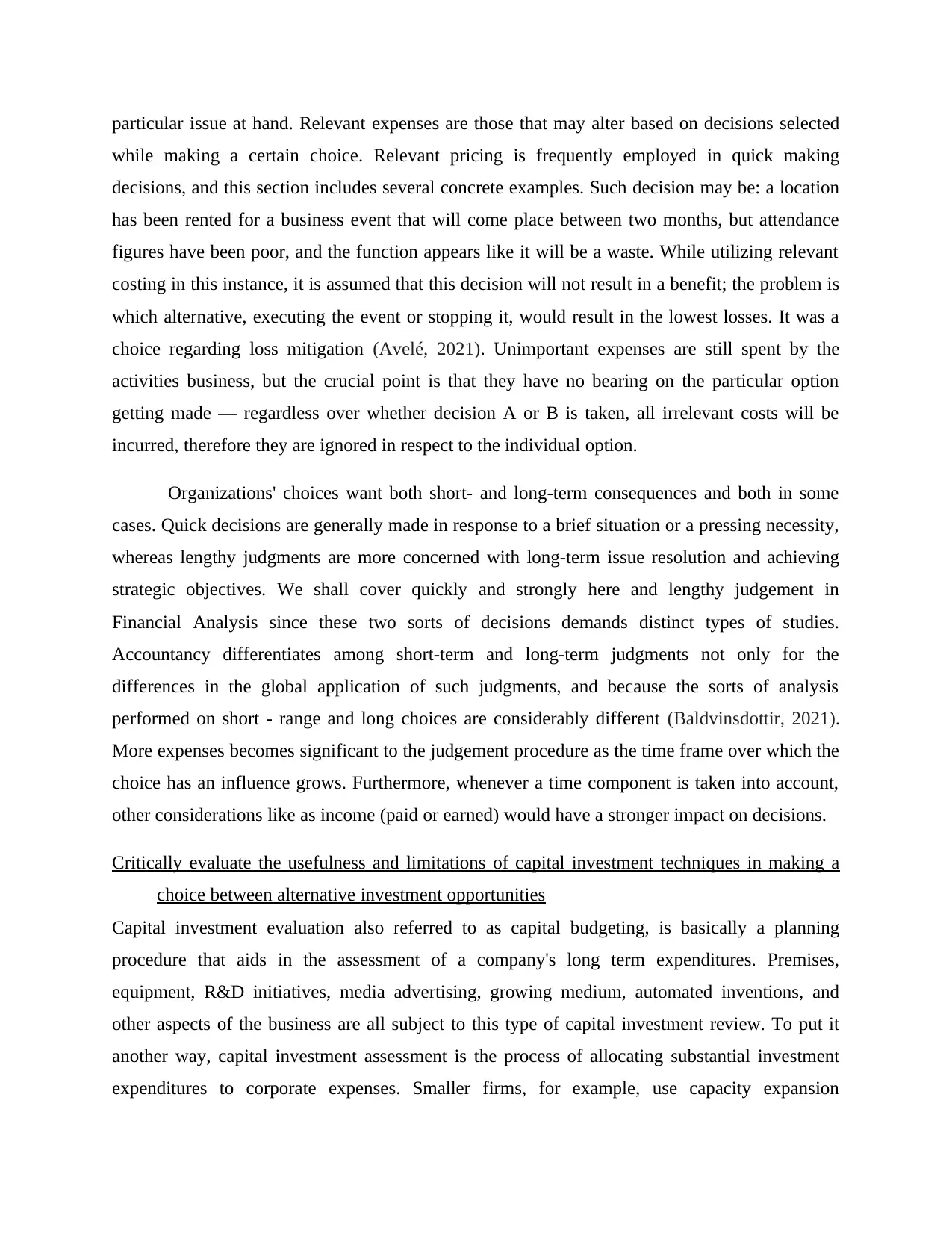
particular issue at hand. Relevant expenses are those that may alter based on decisions selected
while making a certain choice. Relevant pricing is frequently employed in quick making
decisions, and this section includes several concrete examples. Such decision may be: a location
has been rented for a business event that will come place between two months, but attendance
figures have been poor, and the function appears like it will be a waste. While utilizing relevant
costing in this instance, it is assumed that this decision will not result in a benefit; the problem is
which alternative, executing the event or stopping it, would result in the lowest losses. It was a
choice regarding loss mitigation (Avelé, 2021). Unimportant expenses are still spent by the
activities business, but the crucial point is that they have no bearing on the particular option
getting made — regardless over whether decision A or B is taken, all irrelevant costs will be
incurred, therefore they are ignored in respect to the individual option.
Organizations' choices want both short- and long-term consequences and both in some
cases. Quick decisions are generally made in response to a brief situation or a pressing necessity,
whereas lengthy judgments are more concerned with long-term issue resolution and achieving
strategic objectives. We shall cover quickly and strongly here and lengthy judgement in
Financial Analysis since these two sorts of decisions demands distinct types of studies.
Accountancy differentiates among short-term and long-term judgments not only for the
differences in the global application of such judgments, and because the sorts of analysis
performed on short - range and long choices are considerably different (Baldvinsdottir, 2021).
More expenses becomes significant to the judgement procedure as the time frame over which the
choice has an influence grows. Furthermore, whenever a time component is taken into account,
other considerations like as income (paid or earned) would have a stronger impact on decisions.
Critically evaluate the usefulness and limitations of capital investment techniques in making a
choice between alternative investment opportunities
Capital investment evaluation also referred to as capital budgeting, is basically a planning
procedure that aids in the assessment of a company's long term expenditures. Premises,
equipment, R&D initiatives, media advertising, growing medium, automated inventions, and
other aspects of the business are all subject to this type of capital investment review. To put it
another way, capital investment assessment is the process of allocating substantial investment
expenditures to corporate expenses. Smaller firms, for example, use capacity expansion
while making a certain choice. Relevant pricing is frequently employed in quick making
decisions, and this section includes several concrete examples. Such decision may be: a location
has been rented for a business event that will come place between two months, but attendance
figures have been poor, and the function appears like it will be a waste. While utilizing relevant
costing in this instance, it is assumed that this decision will not result in a benefit; the problem is
which alternative, executing the event or stopping it, would result in the lowest losses. It was a
choice regarding loss mitigation (Avelé, 2021). Unimportant expenses are still spent by the
activities business, but the crucial point is that they have no bearing on the particular option
getting made — regardless over whether decision A or B is taken, all irrelevant costs will be
incurred, therefore they are ignored in respect to the individual option.
Organizations' choices want both short- and long-term consequences and both in some
cases. Quick decisions are generally made in response to a brief situation or a pressing necessity,
whereas lengthy judgments are more concerned with long-term issue resolution and achieving
strategic objectives. We shall cover quickly and strongly here and lengthy judgement in
Financial Analysis since these two sorts of decisions demands distinct types of studies.
Accountancy differentiates among short-term and long-term judgments not only for the
differences in the global application of such judgments, and because the sorts of analysis
performed on short - range and long choices are considerably different (Baldvinsdottir, 2021).
More expenses becomes significant to the judgement procedure as the time frame over which the
choice has an influence grows. Furthermore, whenever a time component is taken into account,
other considerations like as income (paid or earned) would have a stronger impact on decisions.
Critically evaluate the usefulness and limitations of capital investment techniques in making a
choice between alternative investment opportunities
Capital investment evaluation also referred to as capital budgeting, is basically a planning
procedure that aids in the assessment of a company's long term expenditures. Premises,
equipment, R&D initiatives, media advertising, growing medium, automated inventions, and
other aspects of the business are all subject to this type of capital investment review. To put it
another way, capital investment assessment is the process of allocating substantial investment
expenditures to corporate expenses. Smaller firms, for example, use capacity expansion
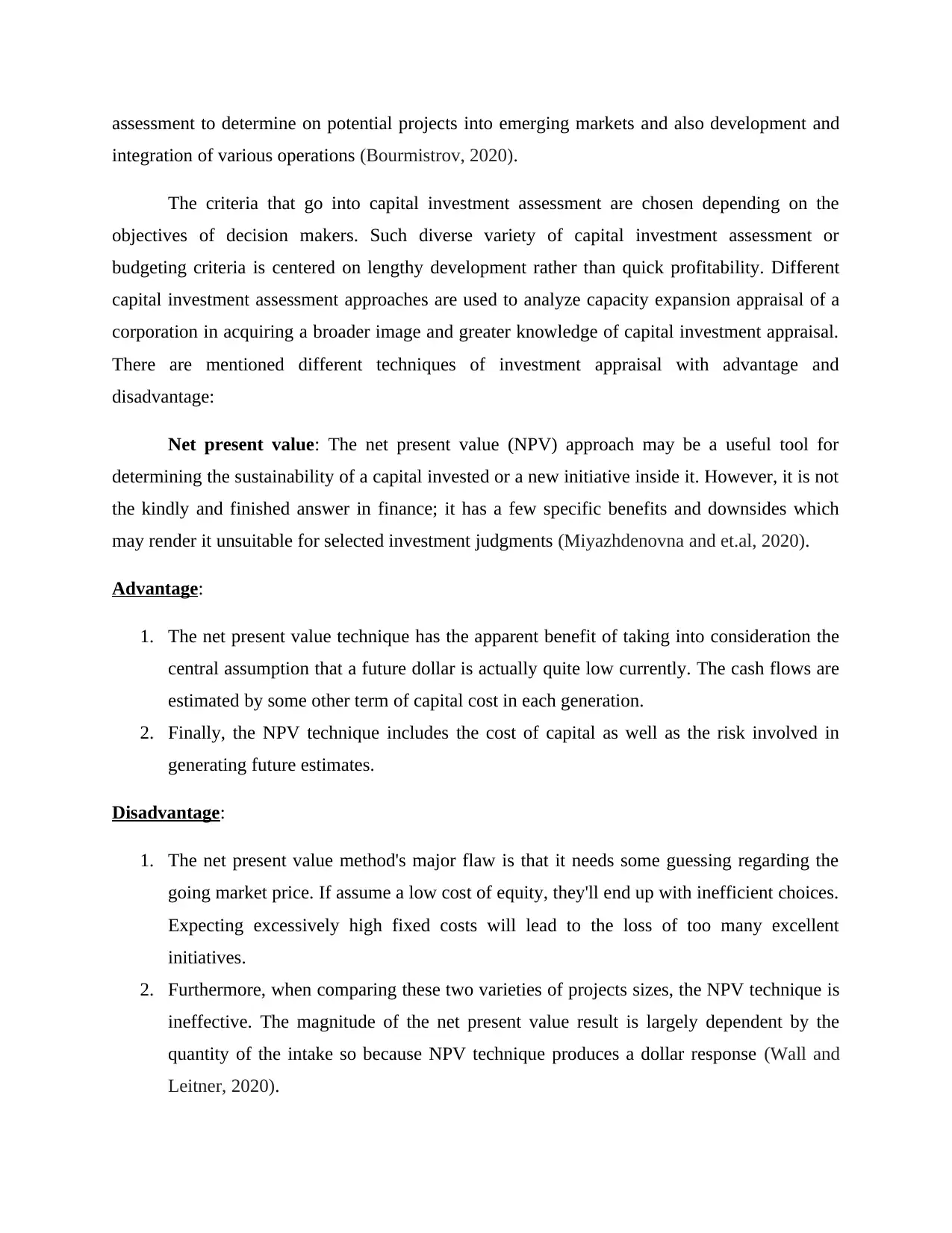
assessment to determine on potential projects into emerging markets and also development and
integration of various operations (Bourmistrov, 2020).
The criteria that go into capital investment assessment are chosen depending on the
objectives of decision makers. Such diverse variety of capital investment assessment or
budgeting criteria is centered on lengthy development rather than quick profitability. Different
capital investment assessment approaches are used to analyze capacity expansion appraisal of a
corporation in acquiring a broader image and greater knowledge of capital investment appraisal.
There are mentioned different techniques of investment appraisal with advantage and
disadvantage:
Net present value: The net present value (NPV) approach may be a useful tool for
determining the sustainability of a capital invested or a new initiative inside it. However, it is not
the kindly and finished answer in finance; it has a few specific benefits and downsides which
may render it unsuitable for selected investment judgments (Miyazhdenovna and et.al, 2020).
Advantage:
1. The net present value technique has the apparent benefit of taking into consideration the
central assumption that a future dollar is actually quite low currently. The cash flows are
estimated by some other term of capital cost in each generation.
2. Finally, the NPV technique includes the cost of capital as well as the risk involved in
generating future estimates.
Disadvantage:
1. The net present value method's major flaw is that it needs some guessing regarding the
going market price. If assume a low cost of equity, they'll end up with inefficient choices.
Expecting excessively high fixed costs will lead to the loss of too many excellent
initiatives.
2. Furthermore, when comparing these two varieties of projects sizes, the NPV technique is
ineffective. The magnitude of the net present value result is largely dependent by the
quantity of the intake so because NPV technique produces a dollar response (Wall and
Leitner, 2020).
integration of various operations (Bourmistrov, 2020).
The criteria that go into capital investment assessment are chosen depending on the
objectives of decision makers. Such diverse variety of capital investment assessment or
budgeting criteria is centered on lengthy development rather than quick profitability. Different
capital investment assessment approaches are used to analyze capacity expansion appraisal of a
corporation in acquiring a broader image and greater knowledge of capital investment appraisal.
There are mentioned different techniques of investment appraisal with advantage and
disadvantage:
Net present value: The net present value (NPV) approach may be a useful tool for
determining the sustainability of a capital invested or a new initiative inside it. However, it is not
the kindly and finished answer in finance; it has a few specific benefits and downsides which
may render it unsuitable for selected investment judgments (Miyazhdenovna and et.al, 2020).
Advantage:
1. The net present value technique has the apparent benefit of taking into consideration the
central assumption that a future dollar is actually quite low currently. The cash flows are
estimated by some other term of capital cost in each generation.
2. Finally, the NPV technique includes the cost of capital as well as the risk involved in
generating future estimates.
Disadvantage:
1. The net present value method's major flaw is that it needs some guessing regarding the
going market price. If assume a low cost of equity, they'll end up with inefficient choices.
Expecting excessively high fixed costs will lead to the loss of too many excellent
initiatives.
2. Furthermore, when comparing these two varieties of projects sizes, the NPV technique is
ineffective. The magnitude of the net present value result is largely dependent by the
quantity of the intake so because NPV technique produces a dollar response (Wall and
Leitner, 2020).
⊘ This is a preview!⊘
Do you want full access?
Subscribe today to unlock all pages.

Trusted by 1+ million students worldwide
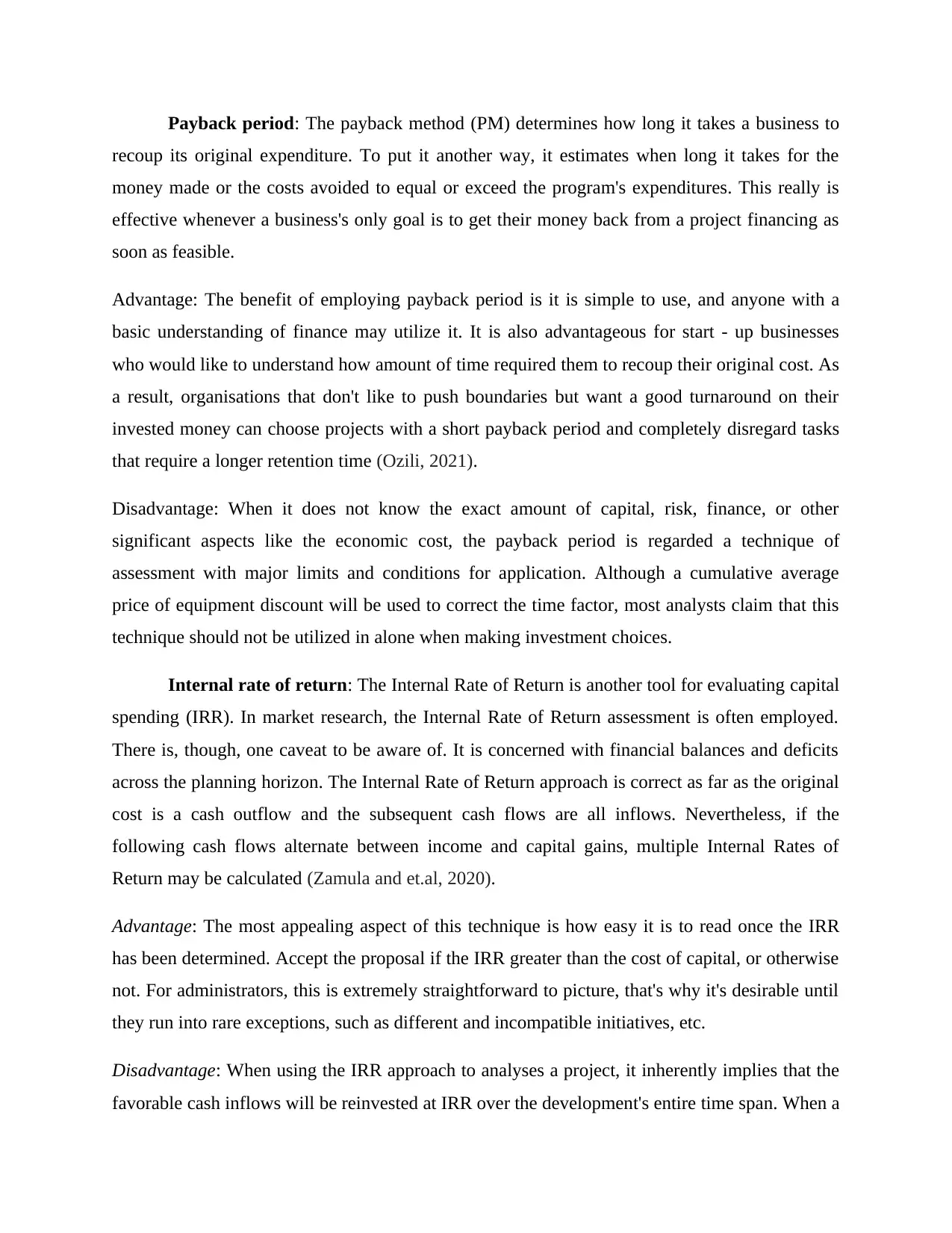
Payback period: The payback method (PM) determines how long it takes a business to
recoup its original expenditure. To put it another way, it estimates when long it takes for the
money made or the costs avoided to equal or exceed the program's expenditures. This really is
effective whenever a business's only goal is to get their money back from a project financing as
soon as feasible.
Advantage: The benefit of employing payback period is it is simple to use, and anyone with a
basic understanding of finance may utilize it. It is also advantageous for start - up businesses
who would like to understand how amount of time required them to recoup their original cost. As
a result, organisations that don't like to push boundaries but want a good turnaround on their
invested money can choose projects with a short payback period and completely disregard tasks
that require a longer retention time (Ozili, 2021).
Disadvantage: When it does not know the exact amount of capital, risk, finance, or other
significant aspects like the economic cost, the payback period is regarded a technique of
assessment with major limits and conditions for application. Although a cumulative average
price of equipment discount will be used to correct the time factor, most analysts claim that this
technique should not be utilized in alone when making investment choices.
Internal rate of return: The Internal Rate of Return is another tool for evaluating capital
spending (IRR). In market research, the Internal Rate of Return assessment is often employed.
There is, though, one caveat to be aware of. It is concerned with financial balances and deficits
across the planning horizon. The Internal Rate of Return approach is correct as far as the original
cost is a cash outflow and the subsequent cash flows are all inflows. Nevertheless, if the
following cash flows alternate between income and capital gains, multiple Internal Rates of
Return may be calculated (Zamula and et.al, 2020).
Advantage: The most appealing aspect of this technique is how easy it is to read once the IRR
has been determined. Accept the proposal if the IRR greater than the cost of capital, or otherwise
not. For administrators, this is extremely straightforward to picture, that's why it's desirable until
they run into rare exceptions, such as different and incompatible initiatives, etc.
Disadvantage: When using the IRR approach to analyses a project, it inherently implies that the
favorable cash inflows will be reinvested at IRR over the development's entire time span. When a
recoup its original expenditure. To put it another way, it estimates when long it takes for the
money made or the costs avoided to equal or exceed the program's expenditures. This really is
effective whenever a business's only goal is to get their money back from a project financing as
soon as feasible.
Advantage: The benefit of employing payback period is it is simple to use, and anyone with a
basic understanding of finance may utilize it. It is also advantageous for start - up businesses
who would like to understand how amount of time required them to recoup their original cost. As
a result, organisations that don't like to push boundaries but want a good turnaround on their
invested money can choose projects with a short payback period and completely disregard tasks
that require a longer retention time (Ozili, 2021).
Disadvantage: When it does not know the exact amount of capital, risk, finance, or other
significant aspects like the economic cost, the payback period is regarded a technique of
assessment with major limits and conditions for application. Although a cumulative average
price of equipment discount will be used to correct the time factor, most analysts claim that this
technique should not be utilized in alone when making investment choices.
Internal rate of return: The Internal Rate of Return is another tool for evaluating capital
spending (IRR). In market research, the Internal Rate of Return assessment is often employed.
There is, though, one caveat to be aware of. It is concerned with financial balances and deficits
across the planning horizon. The Internal Rate of Return approach is correct as far as the original
cost is a cash outflow and the subsequent cash flows are all inflows. Nevertheless, if the
following cash flows alternate between income and capital gains, multiple Internal Rates of
Return may be calculated (Zamula and et.al, 2020).
Advantage: The most appealing aspect of this technique is how easy it is to read once the IRR
has been determined. Accept the proposal if the IRR greater than the cost of capital, or otherwise
not. For administrators, this is extremely straightforward to picture, that's why it's desirable until
they run into rare exceptions, such as different and incompatible initiatives, etc.
Disadvantage: When using the IRR approach to analyses a project, it inherently implies that the
favorable cash inflows will be reinvested at IRR over the development's entire time span. When a
Paraphrase This Document
Need a fresh take? Get an instant paraphrase of this document with our AI Paraphraser
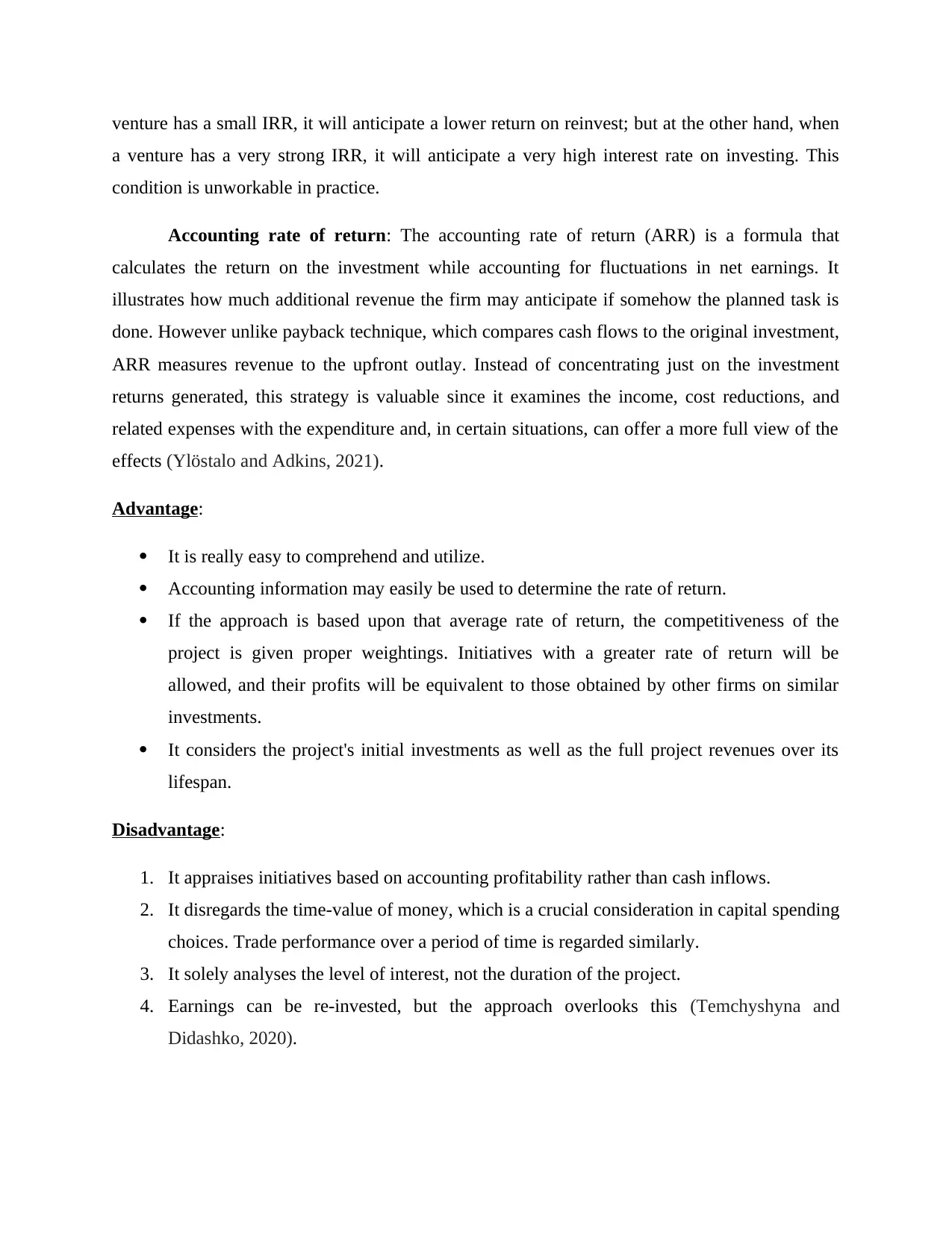
venture has a small IRR, it will anticipate a lower return on reinvest; but at the other hand, when
a venture has a very strong IRR, it will anticipate a very high interest rate on investing. This
condition is unworkable in practice.
Accounting rate of return: The accounting rate of return (ARR) is a formula that
calculates the return on the investment while accounting for fluctuations in net earnings. It
illustrates how much additional revenue the firm may anticipate if somehow the planned task is
done. However unlike payback technique, which compares cash flows to the original investment,
ARR measures revenue to the upfront outlay. Instead of concentrating just on the investment
returns generated, this strategy is valuable since it examines the income, cost reductions, and
related expenses with the expenditure and, in certain situations, can offer a more full view of the
effects (Ylöstalo and Adkins, 2021).
Advantage:
It is really easy to comprehend and utilize.
Accounting information may easily be used to determine the rate of return.
If the approach is based upon that average rate of return, the competitiveness of the
project is given proper weightings. Initiatives with a greater rate of return will be
allowed, and their profits will be equivalent to those obtained by other firms on similar
investments.
It considers the project's initial investments as well as the full project revenues over its
lifespan.
Disadvantage:
1. It appraises initiatives based on accounting profitability rather than cash inflows.
2. It disregards the time-value of money, which is a crucial consideration in capital spending
choices. Trade performance over a period of time is regarded similarly.
3. It solely analyses the level of interest, not the duration of the project.
4. Earnings can be re-invested, but the approach overlooks this (Temchyshyna and
Didashko, 2020).
a venture has a very strong IRR, it will anticipate a very high interest rate on investing. This
condition is unworkable in practice.
Accounting rate of return: The accounting rate of return (ARR) is a formula that
calculates the return on the investment while accounting for fluctuations in net earnings. It
illustrates how much additional revenue the firm may anticipate if somehow the planned task is
done. However unlike payback technique, which compares cash flows to the original investment,
ARR measures revenue to the upfront outlay. Instead of concentrating just on the investment
returns generated, this strategy is valuable since it examines the income, cost reductions, and
related expenses with the expenditure and, in certain situations, can offer a more full view of the
effects (Ylöstalo and Adkins, 2021).
Advantage:
It is really easy to comprehend and utilize.
Accounting information may easily be used to determine the rate of return.
If the approach is based upon that average rate of return, the competitiveness of the
project is given proper weightings. Initiatives with a greater rate of return will be
allowed, and their profits will be equivalent to those obtained by other firms on similar
investments.
It considers the project's initial investments as well as the full project revenues over its
lifespan.
Disadvantage:
1. It appraises initiatives based on accounting profitability rather than cash inflows.
2. It disregards the time-value of money, which is a crucial consideration in capital spending
choices. Trade performance over a period of time is regarded similarly.
3. It solely analyses the level of interest, not the duration of the project.
4. Earnings can be re-invested, but the approach overlooks this (Temchyshyna and
Didashko, 2020).
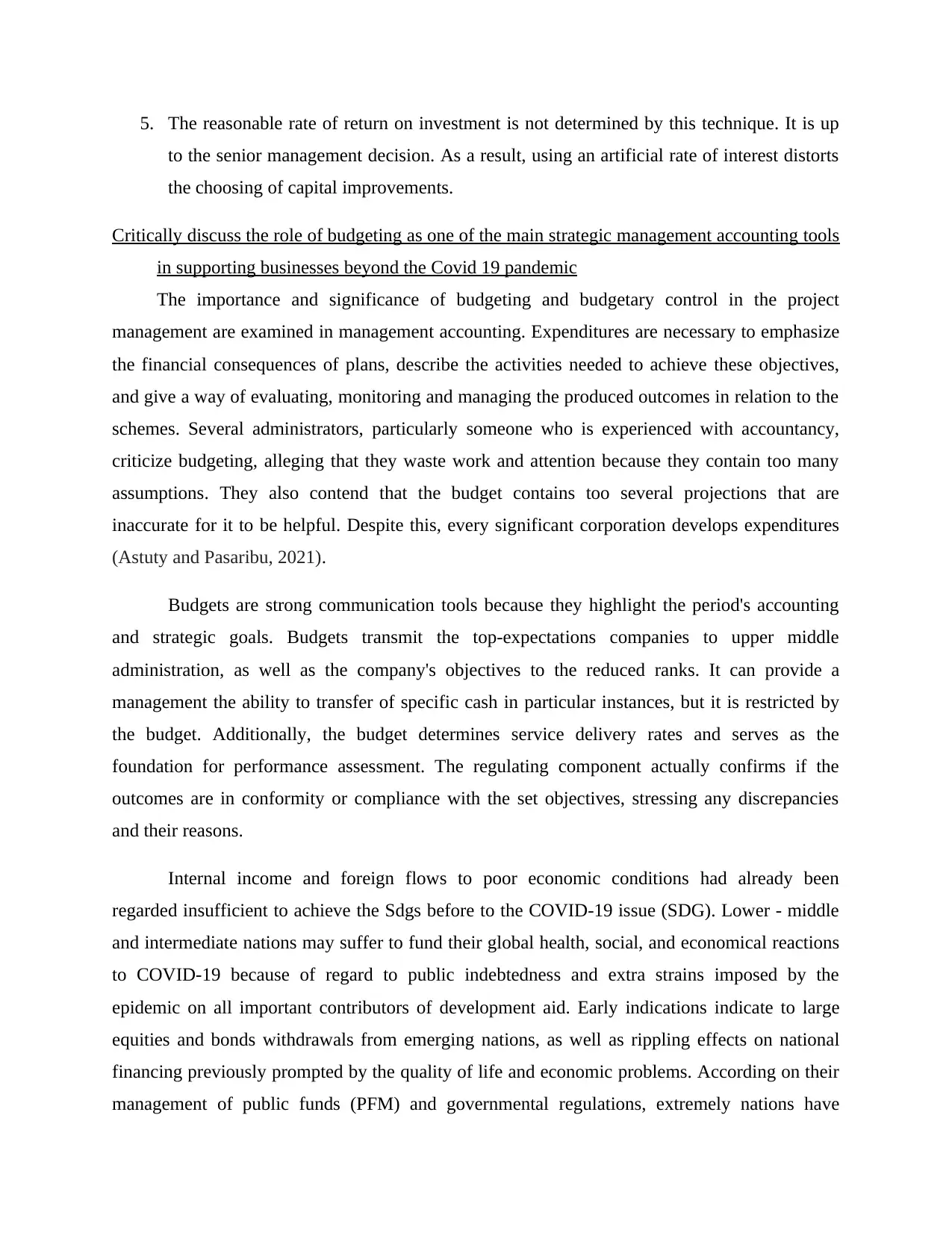
5. The reasonable rate of return on investment is not determined by this technique. It is up
to the senior management decision. As a result, using an artificial rate of interest distorts
the choosing of capital improvements.
Critically discuss the role of budgeting as one of the main strategic management accounting tools
in supporting businesses beyond the Covid 19 pandemic
The importance and significance of budgeting and budgetary control in the project
management are examined in management accounting. Expenditures are necessary to emphasize
the financial consequences of plans, describe the activities needed to achieve these objectives,
and give a way of evaluating, monitoring and managing the produced outcomes in relation to the
schemes. Several administrators, particularly someone who is experienced with accountancy,
criticize budgeting, alleging that they waste work and attention because they contain too many
assumptions. They also contend that the budget contains too several projections that are
inaccurate for it to be helpful. Despite this, every significant corporation develops expenditures
(Astuty and Pasaribu, 2021).
Budgets are strong communication tools because they highlight the period's accounting
and strategic goals. Budgets transmit the top-expectations companies to upper middle
administration, as well as the company's objectives to the reduced ranks. It can provide a
management the ability to transfer of specific cash in particular instances, but it is restricted by
the budget. Additionally, the budget determines service delivery rates and serves as the
foundation for performance assessment. The regulating component actually confirms if the
outcomes are in conformity or compliance with the set objectives, stressing any discrepancies
and their reasons.
Internal income and foreign flows to poor economic conditions had already been
regarded insufficient to achieve the Sdgs before to the COVID-19 issue (SDG). Lower - middle
and intermediate nations may suffer to fund their global health, social, and economical reactions
to COVID-19 because of regard to public indebtedness and extra strains imposed by the
epidemic on all important contributors of development aid. Early indications indicate to large
equities and bonds withdrawals from emerging nations, as well as rippling effects on national
financing previously prompted by the quality of life and economic problems. According on their
management of public funds (PFM) and governmental regulations, extremely nations have
to the senior management decision. As a result, using an artificial rate of interest distorts
the choosing of capital improvements.
Critically discuss the role of budgeting as one of the main strategic management accounting tools
in supporting businesses beyond the Covid 19 pandemic
The importance and significance of budgeting and budgetary control in the project
management are examined in management accounting. Expenditures are necessary to emphasize
the financial consequences of plans, describe the activities needed to achieve these objectives,
and give a way of evaluating, monitoring and managing the produced outcomes in relation to the
schemes. Several administrators, particularly someone who is experienced with accountancy,
criticize budgeting, alleging that they waste work and attention because they contain too many
assumptions. They also contend that the budget contains too several projections that are
inaccurate for it to be helpful. Despite this, every significant corporation develops expenditures
(Astuty and Pasaribu, 2021).
Budgets are strong communication tools because they highlight the period's accounting
and strategic goals. Budgets transmit the top-expectations companies to upper middle
administration, as well as the company's objectives to the reduced ranks. It can provide a
management the ability to transfer of specific cash in particular instances, but it is restricted by
the budget. Additionally, the budget determines service delivery rates and serves as the
foundation for performance assessment. The regulating component actually confirms if the
outcomes are in conformity or compliance with the set objectives, stressing any discrepancies
and their reasons.
Internal income and foreign flows to poor economic conditions had already been
regarded insufficient to achieve the Sdgs before to the COVID-19 issue (SDG). Lower - middle
and intermediate nations may suffer to fund their global health, social, and economical reactions
to COVID-19 because of regard to public indebtedness and extra strains imposed by the
epidemic on all important contributors of development aid. Early indications indicate to large
equities and bonds withdrawals from emerging nations, as well as rippling effects on national
financing previously prompted by the quality of life and economic problems. According on their
management of public funds (PFM) and governmental regulations, extremely nations have
⊘ This is a preview!⊘
Do you want full access?
Subscribe today to unlock all pages.

Trusted by 1+ million students worldwide
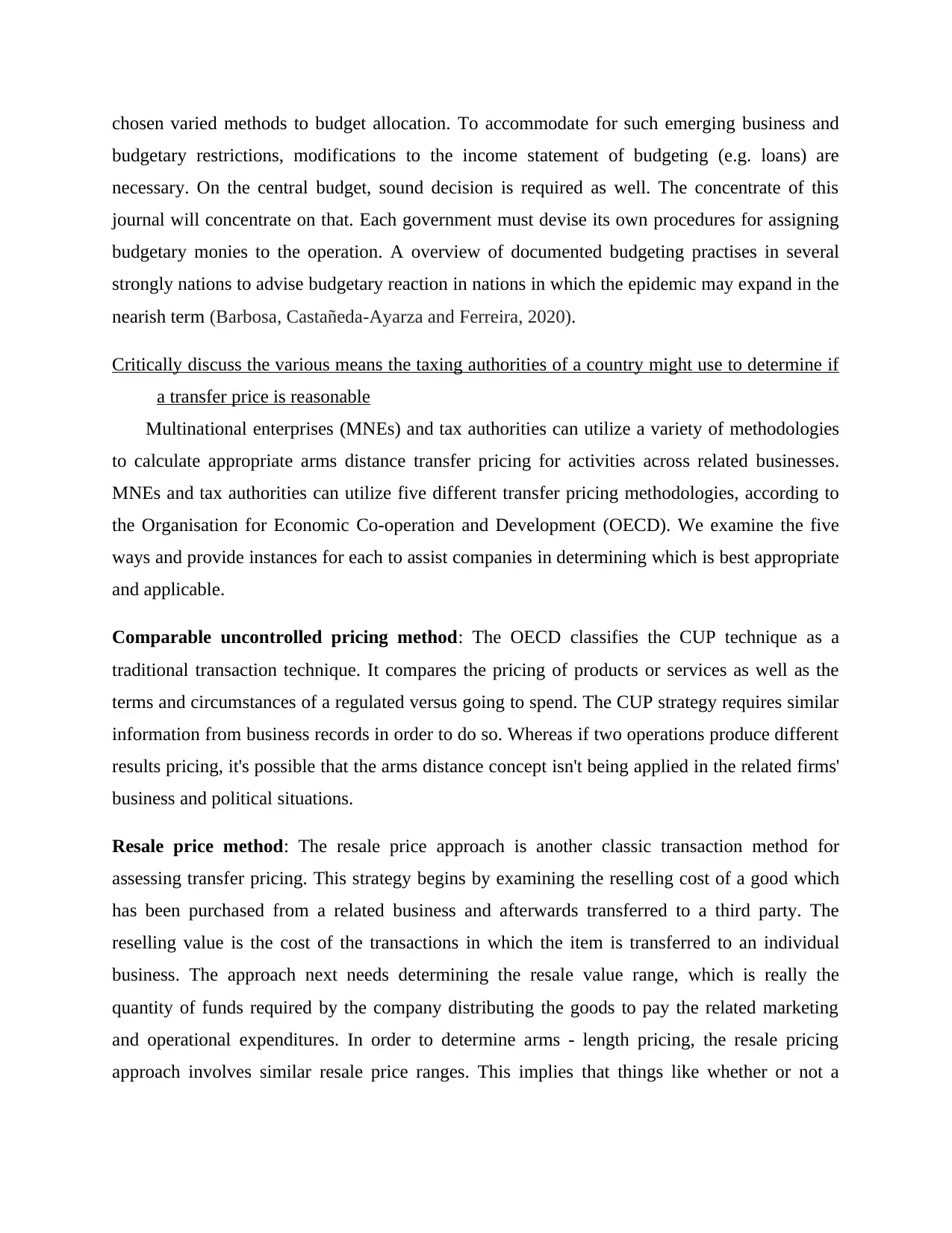
chosen varied methods to budget allocation. To accommodate for such emerging business and
budgetary restrictions, modifications to the income statement of budgeting (e.g. loans) are
necessary. On the central budget, sound decision is required as well. The concentrate of this
journal will concentrate on that. Each government must devise its own procedures for assigning
budgetary monies to the operation. A overview of documented budgeting practises in several
strongly nations to advise budgetary reaction in nations in which the epidemic may expand in the
nearish term (Barbosa, Castañeda-Ayarza and Ferreira, 2020).
Critically discuss the various means the taxing authorities of a country might use to determine if
a transfer price is reasonable
Multinational enterprises (MNEs) and tax authorities can utilize a variety of methodologies
to calculate appropriate arms distance transfer pricing for activities across related businesses.
MNEs and tax authorities can utilize five different transfer pricing methodologies, according to
the Organisation for Economic Co-operation and Development (OECD). We examine the five
ways and provide instances for each to assist companies in determining which is best appropriate
and applicable.
Comparable uncontrolled pricing method: The OECD classifies the CUP technique as a
traditional transaction technique. It compares the pricing of products or services as well as the
terms and circumstances of a regulated versus going to spend. The CUP strategy requires similar
information from business records in order to do so. Whereas if two operations produce different
results pricing, it's possible that the arms distance concept isn't being applied in the related firms'
business and political situations.
Resale price method: The resale price approach is another classic transaction method for
assessing transfer pricing. This strategy begins by examining the reselling cost of a good which
has been purchased from a related business and afterwards transferred to a third party. The
reselling value is the cost of the transactions in which the item is transferred to an individual
business. The approach next needs determining the resale value range, which is really the
quantity of funds required by the company distributing the goods to pay the related marketing
and operational expenditures. In order to determine arms - length pricing, the resale pricing
approach involves similar resale price ranges. This implies that things like whether or not a
budgetary restrictions, modifications to the income statement of budgeting (e.g. loans) are
necessary. On the central budget, sound decision is required as well. The concentrate of this
journal will concentrate on that. Each government must devise its own procedures for assigning
budgetary monies to the operation. A overview of documented budgeting practises in several
strongly nations to advise budgetary reaction in nations in which the epidemic may expand in the
nearish term (Barbosa, Castañeda-Ayarza and Ferreira, 2020).
Critically discuss the various means the taxing authorities of a country might use to determine if
a transfer price is reasonable
Multinational enterprises (MNEs) and tax authorities can utilize a variety of methodologies
to calculate appropriate arms distance transfer pricing for activities across related businesses.
MNEs and tax authorities can utilize five different transfer pricing methodologies, according to
the Organisation for Economic Co-operation and Development (OECD). We examine the five
ways and provide instances for each to assist companies in determining which is best appropriate
and applicable.
Comparable uncontrolled pricing method: The OECD classifies the CUP technique as a
traditional transaction technique. It compares the pricing of products or services as well as the
terms and circumstances of a regulated versus going to spend. The CUP strategy requires similar
information from business records in order to do so. Whereas if two operations produce different
results pricing, it's possible that the arms distance concept isn't being applied in the related firms'
business and political situations.
Resale price method: The resale price approach is another classic transaction method for
assessing transfer pricing. This strategy begins by examining the reselling cost of a good which
has been purchased from a related business and afterwards transferred to a third party. The
reselling value is the cost of the transactions in which the item is transferred to an individual
business. The approach next needs determining the resale value range, which is really the
quantity of funds required by the company distributing the goods to pay the related marketing
and operational expenditures. In order to determine arms - length pricing, the resale pricing
approach involves similar resale price ranges. This implies that things like whether or not a
Paraphrase This Document
Need a fresh take? Get an instant paraphrase of this document with our AI Paraphraser
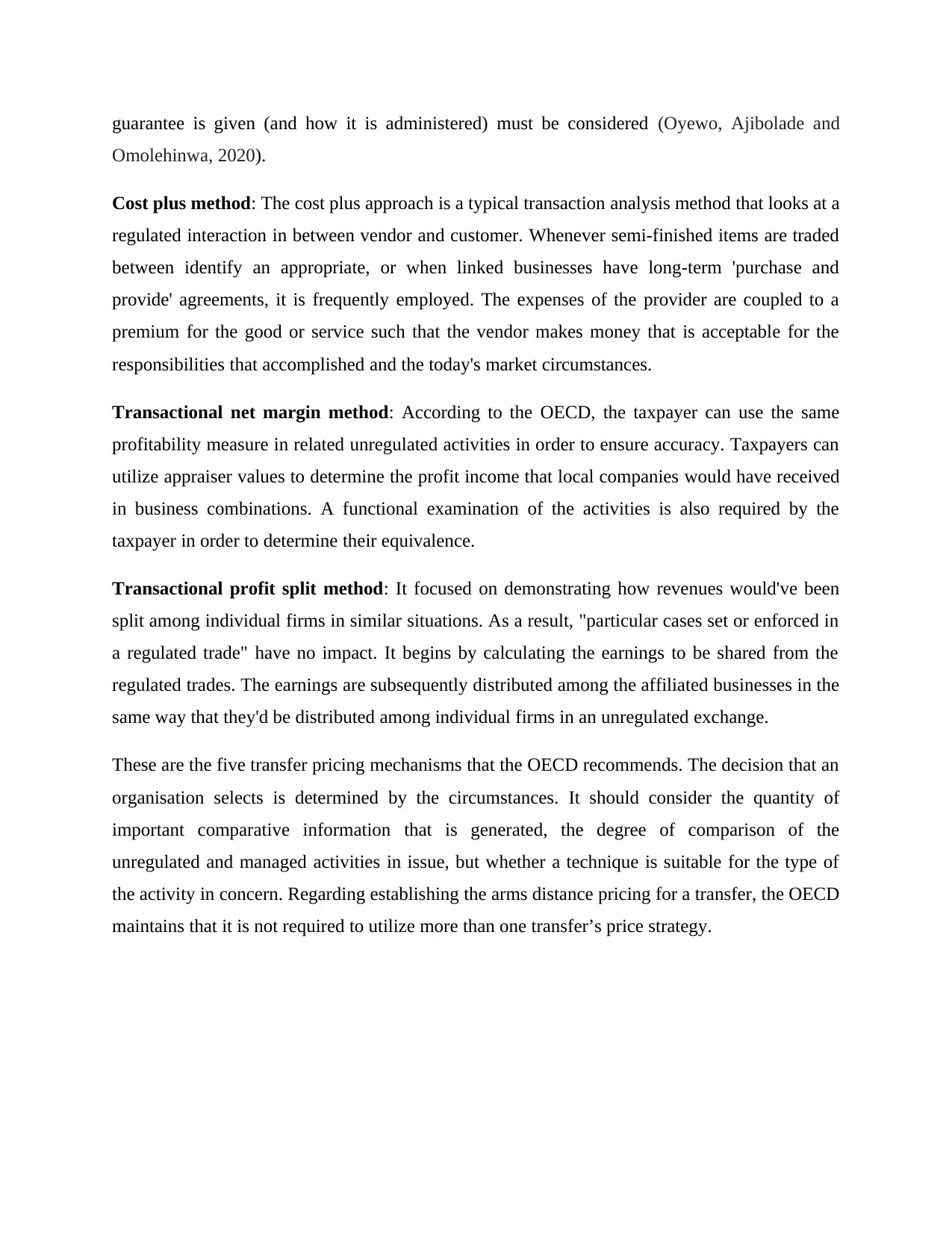
guarantee is given (and how it is administered) must be considered (Oyewo, Ajibolade and
Omolehinwa, 2020).
Cost plus method: The cost plus approach is a typical transaction analysis method that looks at a
regulated interaction in between vendor and customer. Whenever semi-finished items are traded
between identify an appropriate, or when linked businesses have long-term 'purchase and
provide' agreements, it is frequently employed. The expenses of the provider are coupled to a
premium for the good or service such that the vendor makes money that is acceptable for the
responsibilities that accomplished and the today's market circumstances.
Transactional net margin method: According to the OECD, the taxpayer can use the same
profitability measure in related unregulated activities in order to ensure accuracy. Taxpayers can
utilize appraiser values to determine the profit income that local companies would have received
in business combinations. A functional examination of the activities is also required by the
taxpayer in order to determine their equivalence.
Transactional profit split method: It focused on demonstrating how revenues would've been
split among individual firms in similar situations. As a result, "particular cases set or enforced in
a regulated trade" have no impact. It begins by calculating the earnings to be shared from the
regulated trades. The earnings are subsequently distributed among the affiliated businesses in the
same way that they'd be distributed among individual firms in an unregulated exchange.
These are the five transfer pricing mechanisms that the OECD recommends. The decision that an
organisation selects is determined by the circumstances. It should consider the quantity of
important comparative information that is generated, the degree of comparison of the
unregulated and managed activities in issue, but whether a technique is suitable for the type of
the activity in concern. Regarding establishing the arms distance pricing for a transfer, the OECD
maintains that it is not required to utilize more than one transfer’s price strategy.
Omolehinwa, 2020).
Cost plus method: The cost plus approach is a typical transaction analysis method that looks at a
regulated interaction in between vendor and customer. Whenever semi-finished items are traded
between identify an appropriate, or when linked businesses have long-term 'purchase and
provide' agreements, it is frequently employed. The expenses of the provider are coupled to a
premium for the good or service such that the vendor makes money that is acceptable for the
responsibilities that accomplished and the today's market circumstances.
Transactional net margin method: According to the OECD, the taxpayer can use the same
profitability measure in related unregulated activities in order to ensure accuracy. Taxpayers can
utilize appraiser values to determine the profit income that local companies would have received
in business combinations. A functional examination of the activities is also required by the
taxpayer in order to determine their equivalence.
Transactional profit split method: It focused on demonstrating how revenues would've been
split among individual firms in similar situations. As a result, "particular cases set or enforced in
a regulated trade" have no impact. It begins by calculating the earnings to be shared from the
regulated trades. The earnings are subsequently distributed among the affiliated businesses in the
same way that they'd be distributed among individual firms in an unregulated exchange.
These are the five transfer pricing mechanisms that the OECD recommends. The decision that an
organisation selects is determined by the circumstances. It should consider the quantity of
important comparative information that is generated, the degree of comparison of the
unregulated and managed activities in issue, but whether a technique is suitable for the type of
the activity in concern. Regarding establishing the arms distance pricing for a transfer, the OECD
maintains that it is not required to utilize more than one transfer’s price strategy.
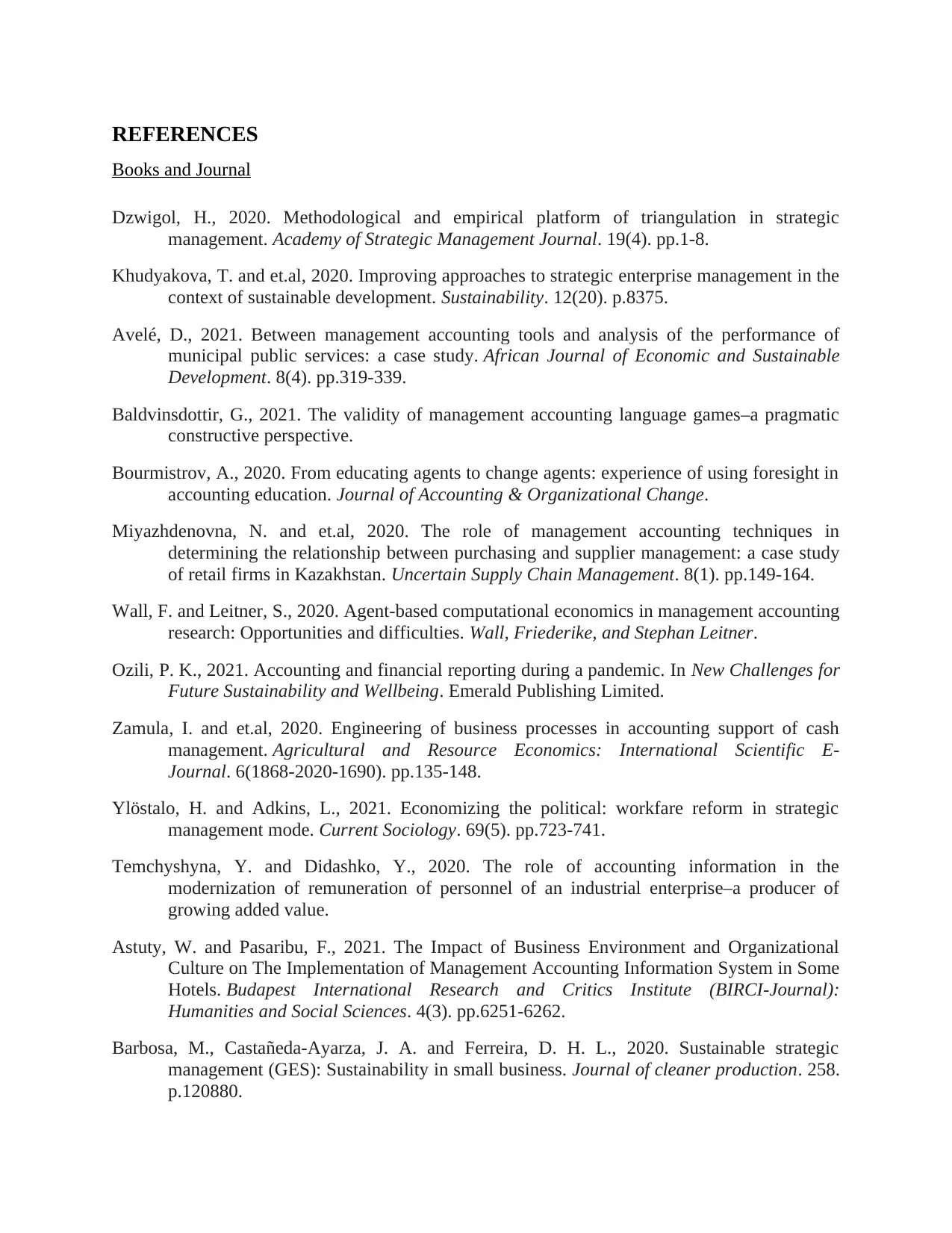
REFERENCES
Books and Journal
Dzwigol, H., 2020. Methodological and empirical platform of triangulation in strategic
management. Academy of Strategic Management Journal. 19(4). pp.1-8.
Khudyakova, T. and et.al, 2020. Improving approaches to strategic enterprise management in the
context of sustainable development. Sustainability. 12(20). p.8375.
Avelé, D., 2021. Between management accounting tools and analysis of the performance of
municipal public services: a case study. African Journal of Economic and Sustainable
Development. 8(4). pp.319-339.
Baldvinsdottir, G., 2021. The validity of management accounting language games–a pragmatic
constructive perspective.
Bourmistrov, A., 2020. From educating agents to change agents: experience of using foresight in
accounting education. Journal of Accounting & Organizational Change.
Miyazhdenovna, N. and et.al, 2020. The role of management accounting techniques in
determining the relationship between purchasing and supplier management: a case study
of retail firms in Kazakhstan. Uncertain Supply Chain Management. 8(1). pp.149-164.
Wall, F. and Leitner, S., 2020. Agent-based computational economics in management accounting
research: Opportunities and difficulties. Wall, Friederike, and Stephan Leitner.
Ozili, P. K., 2021. Accounting and financial reporting during a pandemic. In New Challenges for
Future Sustainability and Wellbeing. Emerald Publishing Limited.
Zamula, I. and et.al, 2020. Engineering of business processes in accounting support of cash
management. Agricultural and Resource Economics: International Scientific E-
Journal. 6(1868-2020-1690). pp.135-148.
Ylöstalo, H. and Adkins, L., 2021. Economizing the political: workfare reform in strategic
management mode. Current Sociology. 69(5). pp.723-741.
Temchyshyna, Y. and Didashko, Y., 2020. The role of accounting information in the
modernization of remuneration of personnel of an industrial enterprise–a producer of
growing added value.
Astuty, W. and Pasaribu, F., 2021. The Impact of Business Environment and Organizational
Culture on The Implementation of Management Accounting Information System in Some
Hotels. Budapest International Research and Critics Institute (BIRCI-Journal):
Humanities and Social Sciences. 4(3). pp.6251-6262.
Barbosa, M., Castañeda-Ayarza, J. A. and Ferreira, D. H. L., 2020. Sustainable strategic
management (GES): Sustainability in small business. Journal of cleaner production. 258.
p.120880.
Books and Journal
Dzwigol, H., 2020. Methodological and empirical platform of triangulation in strategic
management. Academy of Strategic Management Journal. 19(4). pp.1-8.
Khudyakova, T. and et.al, 2020. Improving approaches to strategic enterprise management in the
context of sustainable development. Sustainability. 12(20). p.8375.
Avelé, D., 2021. Between management accounting tools and analysis of the performance of
municipal public services: a case study. African Journal of Economic and Sustainable
Development. 8(4). pp.319-339.
Baldvinsdottir, G., 2021. The validity of management accounting language games–a pragmatic
constructive perspective.
Bourmistrov, A., 2020. From educating agents to change agents: experience of using foresight in
accounting education. Journal of Accounting & Organizational Change.
Miyazhdenovna, N. and et.al, 2020. The role of management accounting techniques in
determining the relationship between purchasing and supplier management: a case study
of retail firms in Kazakhstan. Uncertain Supply Chain Management. 8(1). pp.149-164.
Wall, F. and Leitner, S., 2020. Agent-based computational economics in management accounting
research: Opportunities and difficulties. Wall, Friederike, and Stephan Leitner.
Ozili, P. K., 2021. Accounting and financial reporting during a pandemic. In New Challenges for
Future Sustainability and Wellbeing. Emerald Publishing Limited.
Zamula, I. and et.al, 2020. Engineering of business processes in accounting support of cash
management. Agricultural and Resource Economics: International Scientific E-
Journal. 6(1868-2020-1690). pp.135-148.
Ylöstalo, H. and Adkins, L., 2021. Economizing the political: workfare reform in strategic
management mode. Current Sociology. 69(5). pp.723-741.
Temchyshyna, Y. and Didashko, Y., 2020. The role of accounting information in the
modernization of remuneration of personnel of an industrial enterprise–a producer of
growing added value.
Astuty, W. and Pasaribu, F., 2021. The Impact of Business Environment and Organizational
Culture on The Implementation of Management Accounting Information System in Some
Hotels. Budapest International Research and Critics Institute (BIRCI-Journal):
Humanities and Social Sciences. 4(3). pp.6251-6262.
Barbosa, M., Castañeda-Ayarza, J. A. and Ferreira, D. H. L., 2020. Sustainable strategic
management (GES): Sustainability in small business. Journal of cleaner production. 258.
p.120880.
⊘ This is a preview!⊘
Do you want full access?
Subscribe today to unlock all pages.

Trusted by 1+ million students worldwide
1 out of 13
Related Documents
Your All-in-One AI-Powered Toolkit for Academic Success.
+13062052269
info@desklib.com
Available 24*7 on WhatsApp / Email
![[object Object]](/_next/static/media/star-bottom.7253800d.svg)
Unlock your academic potential
Copyright © 2020–2025 A2Z Services. All Rights Reserved. Developed and managed by ZUCOL.



